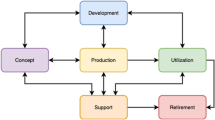Abstract
This paper describes an approach that has been developed over a number of years for the job of scheduling systems and providing evidence that timing requirements are met. The approach has been targeted at the safety-critical systems domain, and more specifically the development of control systems for jet engines. The work provides a usable computational model that supports the reuse of legacy systems. In addition, timing analysis has been developed that features low pessimism, low computational complexity and that is robust to change. The contributions of this paper are to show how standard timing analysis is often insufficient for real systems, presenting extensions to the standard analysis to give an integrated approach to verification, and providing a case study that demonstrates the appropriateness and benefits of the overall technique.
Similar content being viewed by others
References
ARINC June 17, 1996. ARINC 653: Avionics Appliction Software Standard Interface (Draft 15). Airlines Electronic Engineering Committee (AEEC).
Audsley, N. C. 1993. Flexible scheduling of hard real-time systems. Ph.D. thesis, Department of Compuer Science, University of York.
Audsley, N. C., Bate, I. J., and Burns, A. 1996. Putting fixed priority scheduling into engineering practice for safety critical applications. In Proceedings of the Real-Time Technology and Applications Symposium, pp. 2-10.
Audsley, N. C., Burns, A., Richardson, M., Tindell, K., and Wellings, A. J. 1993. Applying new scheduling theory to static priority pre-emptive scheduling. Software Engineering Journal 8(5): 284-292.
Audlsey, N. C., Burns, A., Richardson, M., and Wellings, A. J. 1991. Hard real-time scheduling: the deadline monotonic approach. In Proceedings of the 8th IEEE Workshop on Real-Time Operating Systems and Software, pp. 127-132.
Bate, I. 1998. Scheduling and timing analysis for safety-critical systems. PhD. Thesis, Department of Computer Science, University of York.
Bate, I. J., Burns, A., McDermid, J. A., and Vickers, A. J. 1996. Towards a fixed priority scheduler for an aircraft application. In Proceedings of the 8th Euromicro Workshop on Real-Time Systems, L'Aquilia, Italy, pp. 34-39.
Burns, A., Audsley, N. C., and Wellings, A. J. 1995a. Real-time distributed computing. In Proceedings of the Fifth IEEE Computer Society Workshop on Future Trends of Distributed Computing Systems, pp. 34-40.
Burns, A., and McDermid, J. A. 1994, Real-time safety-critical systems: analysis and synthesis. Software Engineering Journal 9(6): 267-281.
Burns, A., Tindell, K., and Wellings, A. J. 1995b. Effective analysis for engineering real-time fixed priority schedulers. IEEE Transactions on Software Engineering 21(5): 475-480.
Burns, A., and Wellings, A. J. 2001. Real-Time Systems and Programming Languages (3rd edn.), Addison Wesley.
Clark, J. A., and Tindell, K. 1994. Holistic schedulability analysis for distributed hard real time systems. Microprocessing and Microprogramming 50(2-3): 117-134.
Edwards, R. A. 1994. ASAAC phase I harmonized concept summary. In Proceedings ERA Avionics Conferences and Exhibition. London, UK.
Gerber, R., Hong, S., and Sabsena, M. 1994. Guaranteeing end-to-end timing constraints by calibrating intermediate processes. In Proceedings of the 5th IEEE Real-Time Systems Symposium, pp. 192-203.
Grigg, A., and Audsley, N. C. 1997. Towards the timing analysis of integrated modular avionics systems. In Proceedings ERA Avionics Conferernce and Exhibition, pp. 3.1.1-3.1.12.
Gutierrez, J., Garcia, J., and Harbour, M. 1995. Optimized priority assignment for tasks and messages in distributed real-time systems. Journal of IEEE Parallel and Distributed Systems, pp. 124-131.
Gutierrez, J., Garcia, J., and Harbour, M. 1997. On the schedulability analysis for distributed real-time systems. In Proceedings of the 9th Euromicro Workshop on Real-Time Systems, pp. 136-143.
Gutierrez, J., Garcia, J., and Harbour, M. 1998. Best-case analysis for improving the worst-case schedulability test for distributed hard real-time systems. In Proceedings of the 10th Euromicro Workshop on Real-Time Systems, pp. 35-44.
Harter, J. 1984. Response times in level-structured systems. Technical Report CU-CS-269-94, Department of Computer Science, University of Colorado, USA.
Harter, J. 1987. Response times in level-structured systems. ACM Transactions on Computer Systems 5(3): 232-248.
Hutchesson, S., and Hayes, N. 1998. Technology transfer and certification issues in safety critical real-time systems. In Digest of the IEE Colloqium on Real-Time Systems.
Joseph, M. 1985. On a problem in real-time computing. Information Processing Letters 20(4): 173-177.
Joseph, M., and Pandya, P. 1986. Finding response times in a real-time system. Computer Journal 29 A02(5): 390-395.
Katcher, D., Arakawa, H., and Strosnider, J. 1993. Engineering and analysis of fixed priority schedulers. IEEE Transactions on Software Engineering 19(9): 920-934.
Leung, J. Y. T., and Merril, M. L. 1980. A note on preemptive scheduling of periodic real-time tasks. Information processing Letters 11(3): 115-118.
Leung, J. Y. T., and Whitehead, J. 1982. On the complexity of fixed-priority scheduling of periodic, real-time tasks. Performance Evaluation (Netherland) 2(4): 237-250.
Liu, C. L., and Layland, J. W. 1973. Scheduling algorithms for multiprogramming in a hard real-time environment. Journal of the ACM (JACM) 20(1): 40-61.
Locke, C. 1992. Software architecture for hard real-time applications: cyclic executives vs. fixed priority executives. Real-Time Systems Journal 4(1): 37-53.
Sun, J., and Liu, J. 1996. Synchronization protocols in distributed real-time systems. In Proceesings of The 16th International Conferences on Distributed Computing Systems, pp. 38-45.
Yerraballi, R. 1996. Scalability in real-time systems. Ph.D. thesis, Computer Science Department, Old Dominion University.
Author information
Authors and Affiliations
Rights and permissions
About this article
Cite this article
Bate, I., Burns, A. An Integrated Approach to Scheduling in Safety-Critical Embedded Control Systems. Real-Time Systems 25, 5–37 (2003). https://doi.org/10.1023/A:1022920502619
Issue Date:
DOI: https://doi.org/10.1023/A:1022920502619




